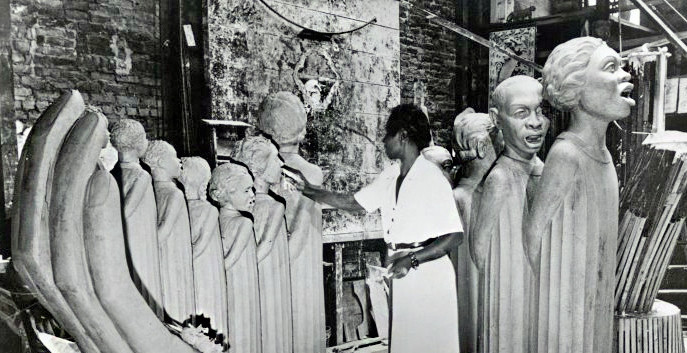Augusta Savage was an African-American sculptor associated with the Harlem Renaissance.
Born in Florida in 1892 Augusta Savage knew early on that she wanted to be an artist. However, the road to creating was not an easy one for her. She was not encouraged at home and she was born into a generation of racism in the South.
Skipping school at times, she enjoyed sculpting animals and other small figures. Her father didn’t approve of this frivolous activity and did whatever he could to stop her.
Savage once said that her father “almost whipped all the art out of me.”
A Monument of Hope and Beauty
Despite her father’s objections and the racism that she encountered, she went on to make a name for herself. Her experiences became part of the passion that she expressed in her work and the passion she expressed through teaching. Throughout her life, she taught art and especially enjoyed inspiring and encouraging young talented artists.
She advanced through her studies of art at the Cooper Union for the Advancement of Science and Art where she finished the four-year program in three years. She was recommended by Harlem librarian Sadie Peterson (later Delaney), for a commission of a bust of W.E.B. DuBois. The sculpture was well received and she began sculpting busts of other African American leaders, including Marcus Garvey.
The sculpture that brought her the most fame was one of an expressive Harlem child, titled Gamin (1929). The work was also instrumental in awarding her a scholarship to study at the Academie de la Grande Chaumiere in Paris. A few years earlier in 1922, she had received the French scholarship but the offer was rescinded when white Alabama students who had received similar grants refused to travel to France unless she was removed from the group.
Her unsuccessful appeal against that loss initiated her lifelong fight for civil rights and the recognition of black artists.
In the late 1930s, Savage was commissioned to create a sculpture for the 1939 New York World’s Fair. The piece, The Harp, inspired by James Weldon Johnson’s poem “Lift Every Voice and Sing,” became one of her best-known.
In 1940 she retired from art and moved to a farm in New York where she lived in rural obscurity. She passed away on March 26, 1962. While she was all but forgotten at the time of her death, Savage is remembered today as a great artist, activist, and arts educator.
I have created nothing really beautiful, really lasting, but if I can inspire one of these youngsters to develop the talent I know they possess, then my monument will be in their work.
-Augusta Savage









